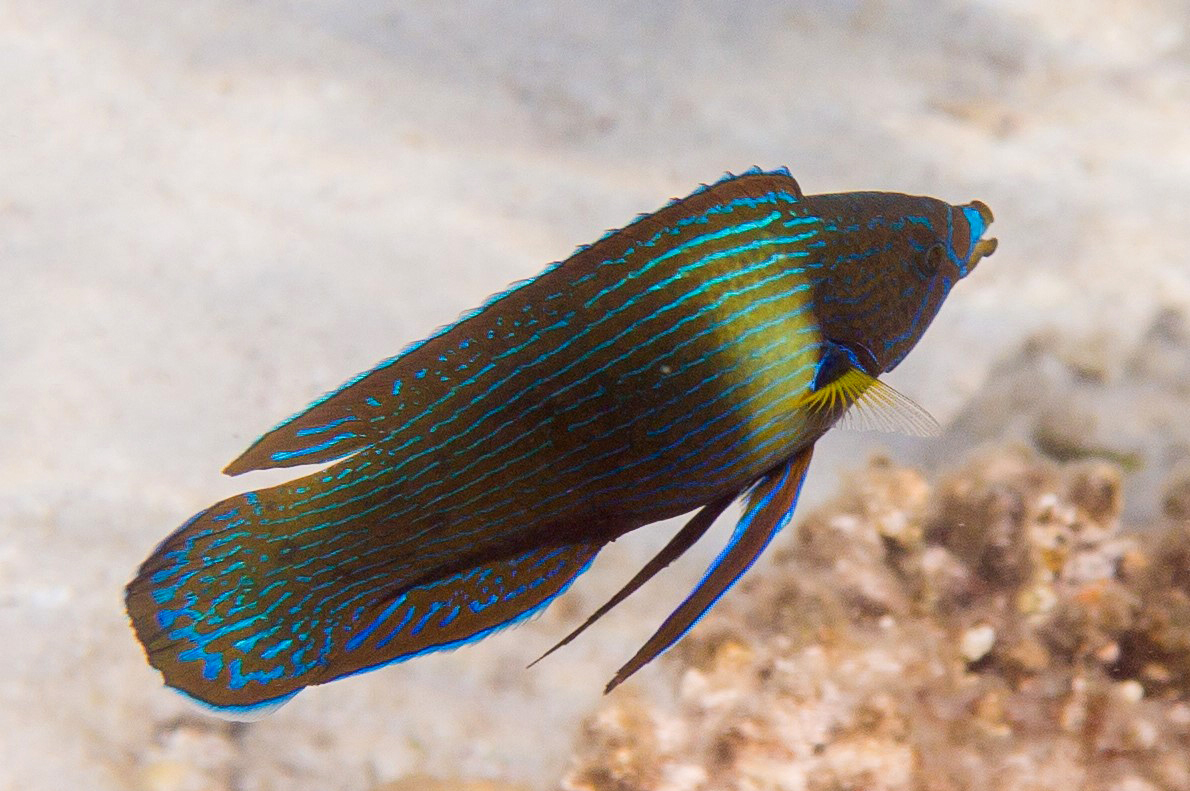- Classification
- ACTINOPTERYGII
- PERCIFORMES
- LABRIDAE
- Labrichthys
- unilineatus
Oneline Wrasse, Labrichthys unilineatus (Guichenot 1847)
Other Names: Onelined Wrasse, One-lined Wrasse, Tube-lip, Tubelip Wrasse, Tube-mouth, Tube-mouth Wrasse

A terminal phase (male) Oneline Wrasse, Labrichthys unilineatus, in Coral Bay, Ningaloo Reef, Western Australia, 17 Sep 2015. Source: Keith Ross-Jones. License: All rights reserved
Summary:
The yellowish-brown males have narrow bright blue stripes along the sides, and a broad whitish to pale yellow bar behind the pectoral-fin base. The duller females lack the pale bar on the sides. Juveniles are dark brown to blackish with a white to pale bluish midlateral stripe, and a narrower stripe along the lower side. The thick fleshy 'tubular' lips are often yellow.
Cite this page as:
Labrichthys unilineatus in Fishes of Australia, accessed 20 Apr 2024, https://fishesofaustralia.net.au/Home/species/249
Oneline Wrasse, Labrichthys unilineatus (Guichenot 1847)
More Info
|
Distribution |
Houtman Abrolhos to the Monte Bello Islands and offshore reefs of north Western Australia, and the far northern Great Barrier Reef to the Capricorn Group, Queensland; also Christmas Island in the eastern Indian Ocean, and the Lord Howe Province in the Tasman Sea. Elsewhere the species is widespread in the Indo-west-central Pacific: from East Africa, Madagascar, Aldabra and western Mascarenes east to the Society Islands, south to Australia, Lord Howe Island, New Caledonia and Tonga, north to Japan. Inhabits areas with dense coral cover in shallow lagoon and semi-protected seaward reefs. |
|
Features |
Dorsal fin IX, 11-12; Anal fin III, 10-11. Lips thick and fleshy, forming a short tube when mouth d; head entirely scaled except for sheath over base of upper lip, preorbital, and chin. Teeth absent in upper jaw between the two anterior pairs of canines and the large canine in each corner. |
|
Colour |
Juveniles brown with 2 bluish white stripes on body, the lateral stripe disappearing with increase in size; female yellowish brown, stripes dull and faint; male color more intensified and brighter than female color, a large yellow area beneath and above the pectoral fin base; lips yellow. |
|
Feeding |
Feeds on coral polyps, especially those of the genus Acropora (staghorn corals). |
|
Remarks |
The Oneline Wrasse is the only species in the genus Labrichthys. The common name refers to the pale midlateral stripe of juveniles. |
|
Etymology |
The specific name unilineatus is from the Latin uni- (= one) and lineatus (= lined), in reference to the white mid-lateral stripe on juveniles. |
|
Species Citation |
Cossyphus unilineatus Guichenot, 1847, Rev. Zool. Paris 10: 284. Type locality: Guam. |
|
Resources |
Oneline Wrasse, Labrichthys unilineatus (Guichenot 1847)
References
Allen, G.R. & Erdmann, M.V. 2012. Reef fishes of the East Indies. Perth : Tropical Reef Research 3 vols, 1260 pp.
Allen, G.R. & Steene, R.C. 1979. The Fishes of Christmas Island, Indian Ocean. Australian National Parks and Wildlife Service Special Publication 2. Canberra : Australian Government Publishing Service 81 pp. 15 pls.
Allen, G.R. & Swainston, R. 1988. The Marine Fishes of North-Western Australia. A field guide for anglers and divers. Perth, WA : Western Australian Museum vi 201 pp., 70 pls.
Cole, A.J, Pratchett, M.S. & Jones, G.P. 2010. Corallivory in tubelip wrasses: diet, feeding and trophic importance. Journal of Fish Biology 76(4): 818-835.
Francis, M.P. 1993. Checklist of the coastal fishes of Lord Howe, Norfolk, and Kermadec Islands, Southwest Pacific Ocean. Pacific Science 47(2): 136-170.
Guichenot, A. 1847. Description de deux nouvelles espèces de Cossyphes. Revue de Zoologie, Paris 10: 282-284.
Kuiter, R.H. 1992. Tropical Reef-Fishes of the Western Pacific, Indonesia and Adjacent Waters. Jakarta : PT Gramedia Pustaka Utama 314 pp. pls.
Kuiter, R.H. 1996. Guide to Sea Fishes of Australia. A comprehensive reference for divers and fishermen. Sydney, NSW, Australia : New Holland Publishers xvii, 434 pp.
Kuiter, R.H. 2002. Fairy and rainbow wrasses and their relatives – a comprehensive guide to selected labrids. TMC Publishing, Chorleywood, UK.
Kuiter, R.H. 2010. Labridae fishes: wrasses. Seaford, Victoria, Australia : Aquatic Photographics 398 pp.
Marshall, T.C. 1964. Fishes of the Great Barrier Reef and Coastal Waters of Queensland. Sydney : Angus & Robertson 566 pp. 136 pls.
Pollard, D. 2010. Labrichthys unilineatus. The IUCN Red List of Threatened Species. Version 2014.2.
Randall, J.E. & Springer, V.C. 1973. The monotypic Indo-Pacific labrid fish genera Labrichthys and Diproctacanthus with description of a new related genus, Larabicus. Proceedings of the Biological Society of Washington 86(23): 279-298.
Sano, M., Shimizu, M. & Nose, Y. 1984. Food habits of teleostean reef fishes in Okinawa Island, southern Japan.University of Tokyo Press, Tokyo, Japan. 128 pp.
Westneat, M.W. 2001. Labridae. pp. 3381-3467 in Carpenter, K.E. & Niem, T.H. (eds). The Living Marine Resources of the Western Central Pacific. FAO Species Identification Guide for Fisheries Purposes. Rome : FAO Vol. 6 pp. 3381-4218.















